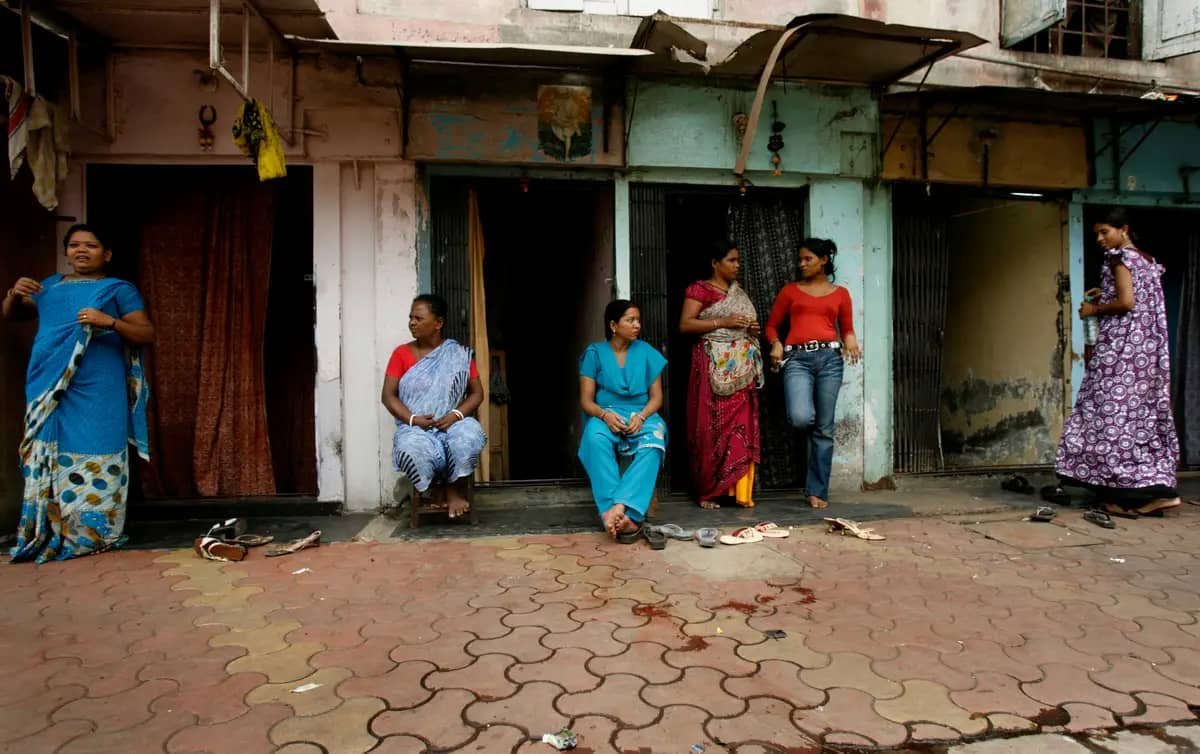
Kamathipura Mumbai’s famous red-light area which is known for the flesh trade business. It was established after 1795 with the construction of causeways that connected the erstwhile seven islands of Mumbai. Initially known as Lal Bazaar, it got its name from the Kamathi (workers) of other areas of the country, who were laborers on construction sites. Due to tough police crackdowns, in the late 1990s, with the rise of AIDS and the government’s redevelopment policy that helped sex workers move out of the profession and subsequently out of Kamathipura, the numbers of sex workers in the area declined.
Before the completion of the Hornby Vellard project in 1784, which built a causeway uniting all seven islands of Mumbai under William Hornby, governor of Bombay (1771–1784), it plugged the Great Breach in Mahalaxmi, while the subsequent Bellasis Road causeway joined Mazagaon and Malabar Hill in 1793. This resulted in several low-lying marshy areas of the Mumbai Flats, like Byculla, Tardeo, Mahalaxmi, and Kamathipura, opening up for habitation. Thereafter, starting in 1795, Kamathis (workers) from other areas of the country, working as laborers on construction sites, began settling here, giving the area its present name. It was bounded by Bellasis Road on the north, Gaodevi on the south, and the main road across, Falkland Road. At one point during this period, it was home to a Chinese community, which worked as dockhands and ran restaurants.
By the late 19th century, it had all changed. As previous 1864 Census figures for Mumbai indicate, other areas had a larger population of prostitutes, like Girgaon (1,044), Phanaswadi (1,323), and Oomburkharee (1,583), compared with Kamathipura (601), all of which declined after 1864. This small region boasted the most exotic consorts. In the 19th and early 20th centuries, a large number of women from continental Europe, Japan, and China were trafficked into Kamathipura, where they worked as prostitutes, servicing soldiers and locals alike. Gradually, social stratification also took place: a busy road in Kamathipura was known as Safed Gully owing to the European prostitutes housed here during the British era.
The lane is now known as Cursetji Shuklaji Street. The most well-known brothel in the area, Pila House, is a hybridization of its original word: playhouse. The first venereal disease clinic in Bombay was opened in 1916, and it was taken over by BMC in 1925. Nearby, Bachu Seth ki Wadi on Foras Road was famous for its kothewalis, or tawaifs and mujras.
When India gained independence, Indian sex workers moved into the area. In recent decades, large numbers of Nepalese women and girls have also been trafficked into the district. Over the years, under Indian government rule, the sex industry in Kamathipura continued to flourish. Trafficking and economic circumstances also brought women from different parts of the country there. Eventually, it became Asia’s largest sex district.
The brothels in the area are crowded. Sex workers wait outside to pick up customers and then rent an available bed. The estimated 3,000 buildings in the area are largely dilapidated; safe drinking water and sanitation are threatened in this area. The movie Gangubai described the exact politics of this area. There were a lot of wonder world activities in this area; in the 1970s and early ’80s, Bachchu Wadi at Kamathipura was frequented by gang leaders from the Mumbai underworld, such as Haji Mastan, Karim Lala, and Dawood Ibrahim.
In 1992, the Mumbai Municipal Corporation recorded that there were 45,000 sex workers here, which were reduced to 1,600 in 2009 and 500 in 2018. Many sexual workers have migrated to other areas of Maharashtra, with real estate developers taking over the high-priced lands. In 2018, the Maharashtra government sought tenders to demolish and redevelop this area. Kamathipura is one of the prime locations in south Mumbai.
This is not the first time that a proposal has been put forth for the redevelopment of Kamathipura. In the 1980s, Mhada carried out a comprehensive survey as the first step towards transforming the entire neighborhood through an urban renewal proposal, but the project was stalled citing financial risks. In 2005, a local private developer expressed his interest in undertaking the redevelopment of a large part of Kamathipura, according to a report prepared by the Tata Institute of Social Sciences.
This time the state government has decided to constitute three different committees to ensure that the project is successfully executed and without delays. The first committee, called the “project feasibility committee,” will consist of Mhada and BMC officials who will determine the actual area that will come under redevelopment, determine the eligibility of the tenants, and help in getting approvals from at least 51 percent of tenants to take the project ahead.
Kamathipura is divided into roughly 14 lanes and divided according to the regional backgrounds of the workers. Most of the workers come from other Indian states. There is little interaction between areas, which makes it harder for social organizations to organize them into a movement or union. Further, a lack of public opinion, political leadership, or social activism that is empathetic towards them means a tough time forming unions. The area had 55,936 voters in 2007. Since 2015, when the BJP came to power in Mumbai, they have focused on the development of all these neglected and dilapidated areas.
For speedy implementation of the project, a high-powered committee headed by the additional chief secretary of the housing department will clear all the proposals related to the project. The committee will also examine the DPR prepared by MHADA, approve the appointment of the developer, review the project at regular intervals, and coordinate with various government departments. The present government is committed to the development, and they have plans to give it a facelift. Mumbaikar are curious to know how the new Kamathipura would look like.
Various Sources

